Mercury Monterey
The Mercury Monterey is a series of full-size cars that were manufactured and marketed by the Mercury division of Ford from 1952 to 1974. Deriving its name from Monterey Bay, the Mercury Monterey served as the replacement for the Mercury Eight, the debut model line of the Mercury division. During its production, the Monterey would be offered in multiple body styles, ranging from coupes, sedans, hardtops, and station wagons.
| Mercury Monterey | |
|---|---|
1971 Mercury Monterey 4-door hardtop | |
| Overview | |
| Manufacturer | Mercury (Ford) |
| Production | 1952–1974 |
| Assembly | St. Louis, Missouri Maywood, California Pico Rivera, California Atlanta, Georgia Mahwah, New Jersey |
| Body and chassis | |
| Class | Full-size |
| Body style | 4-door sedan 2-door sedan 2-door coupe |
| Layout | FR layout |
| Chronology | |
| Predecessor | Mercury Eight |
| Successor | Mercury Marquis |
Over its 22 years of production, the Monterey served as the flagship, mid-range, and entry-level offering of the full-size Mercury product range. The only Mercury nameplate to be in continuous production throughout the 1960s[1], the Monterey was slotted above the Medalist, Custom, and Meteor; later, it was slotted below the Turnpike Cruiser, Montclair, Park Lane, and Marquis.
Following the 1974 model year, Mercury discontinued the Monterey, consolidating its full-size range down to the Marquis and Colony Park station wagon. For 2004, the Monterey nameplate was revived, becoming the counterpart of the Ford Freestar minivan; it was produced through the 2007 model year.
Early history
The Monterey (model 72C) was introduced in 1950 as a high-end two-door coupe as part of the Mercury Eight series in the same vein as the Ford Crestliner, the Lincoln Lido coupe and the Lincoln Cosmopolitan Capri coupe in order to compete with the hardtop coupes General Motors had introduced the previous model year. Montereys had either a canvas covered top for $2146 or vinyl for $2157. Standard features included leather faced seats, simulated leather headliner, wool carpets, chrome-plated interior garnish moldings, two-toned dashboard, special black steering wheel, fender skirts, dual outside rearview mirrors, full wheelcovers & gold winged hood ornament. For $10 more all leather seats were an option. Two special colors were offered, Turquoise Blue with dark blue top and Cortaro Red metallic with black top. Black with yellow top was also available. Few Montereys were sold.
1952–1954
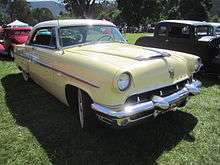
| First generation | |
|---|---|
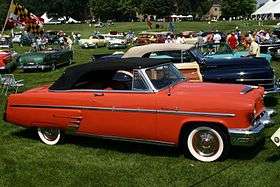 | |
| Overview | |
| Model years | 1952–1954 |
| Body and chassis | |
| Body style | 4-door sedan 2-door hardtop 2-door convertible 4-door station wagon |
| Related | Lincoln Capri Ford Crestline Skyliner |
| Powertrain | |
| Engine | 255 cu in (4.2 L) Flathead V8 256 cu in (4.2 L) Ford Y-block V8 |
| Transmission | 3-speed manual[2] 3-speed Merc-O-Matic automatic[3] |
| Dimensions | |
| Wheelbase | 118.0 in (2,997 mm)[2] |
| Length | 202.2 in (5,136 mm) (1952) |
| Width | 73.5 in (1,867 mm)[4] |
.jpg)
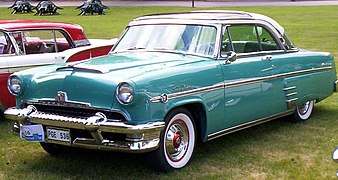
Mercury got a styling and engineering redesign for 1952, such as 18% more window area.[2][5] Monterey became a separate series and Mercury's top model line, a convertible and four-door sedan were included in the new series lineup. The heater and vent controls were changed to levers and placed on a plane set perpendicular to the dash behind the steering wheel, inspired by flight controls in large aircraft.[6] A station wagon bowed for 1953, the same year a Siren Red Monterey Convertible became Ford's forty-millionth car produced.[7] 1954 saw the introduction of the new 161 hp (120 kW) overhead valve Ford Y-block V8, as well as the bubble-top Monterey Sun Valley, which had a Plexiglas front half roof which was similar to that of the Ford Crestline Skyliner.[2] The 1954 Montereys also received other alterations, such as new, lower taillights. The Mercury XM-800 concept car, first displayed at the Chicago Auto Show early in 1954, debuted as the Mercury Monterey XM-800.[8][9][10]
1955–1956

| Second generation | |
|---|---|
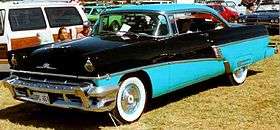 | |
| Overview | |
| Model years | 1955–1956 |
| Body and chassis | |
| Body style | 4-door sedan 4-door hardtop 2-door hardtop 2-door convertible 4-door station wagon |
| Related | Lincoln Capri Mercury Custom Mercury Medalist Mercury Montclair |
| Powertrain | |
| Engine | 292 cu in (4.8 L) Ford Y-block V8 312 cu in (5.1 L) Ford Y-block V8 |
| Transmission | 3-speed manual[2] 3-speed Merc-O-Matic automatic |
| Dimensions | |
| Wheelbase | 119.0 in (3,023 mm) 118.0 in (2,997 mm) (wagons)[2] |
| Length | 206.3 in (5,240 mm)[11] |
For 1955 the car lost its status as Mercury's top model, replaced by the Montclair. The same year, it gained the 292 cu in (4.8 L) Y-block from the Thunderbird, producing 188 hp (140 kW) with the standard transmission or 198 with the Merc-O-Matic.[12] It used independent ball-joint front suspension.[13] Brake size was increased.[14] It was available in two lower-priced trim packages called the Custom and with Medalist as the most basic model. The Medalist lasted only one year as Mercury moved further upscale in 1957.
1956 brought another new engine, the 235 hp (175 kW) 312 cu. in.[12] This year, along with the rest of Ford, Mercury cars started to sport the Lifeguard safety equipment.[15] The deep-dish steering wheel and safety door locks were standard.[15]
1957–1958

| Third generation | |
|---|---|
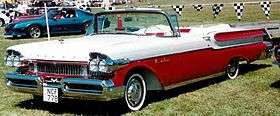 | |
| Overview | |
| Model years | 1957–1958 |
| Body and chassis | |
| Body style | 4-door sedan 4-door hardtop 2-door sedan 2-door hardtop 2-door convertible |
| Related | Mercury Turnpike Cruiser Mercury Montclair Mercury Colony Park Mercury Voyager Mercury Commuter |
| Powertrain | |
| Engine | 312 cu in (5.1 L) Ford Y-block V8 368 cu in (6.0 L) Lincoln Y-Block V8 383 cu in (6.3 L) MEL V8 430 cu in (7.0 L) MEL V8 |
| Transmission | 3-speed manual 3-speed Merc-O-Matic automatic |
| Dimensions | |
| Wheelbase | 122.0 in (3,099 mm) |
| Length | 211.1 in (5,362 mm)[2] |
.jpg)
The fullsize Mercury was redesigned for 1957 and grew considerably larger as well, riding on an exclusive 122 in (3,099 mm) wheelbase. A new frame design allowed a lower floor which made the car look lower and longer. Interior features included a front seat track stop(to keep the front seat from breaking loose), a new design for the safety steering wheel, a new radio, and memory power front seats.[16][17] The station wagons were divested from the Monterey series, with the Commuter, Voyager, and Colony Park lines. The 312 Ford Y-block gained 20 horsepower to go with the added weight, and the 290 hp (220 kW) 368 cu in (6.0 L) Lincoln Y-block V8 became an option.[12] Early 1957 Montereys had two headlights however later examples were fitted with four.[18]
1958 brought an all-new engine: the 383 cu in (6.3 L) MEL V8. With the new engine came the Multi-Drive three-speed automatic transmission.[19]
1959–1960
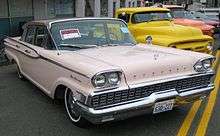
| Fourth generation | |
|---|---|
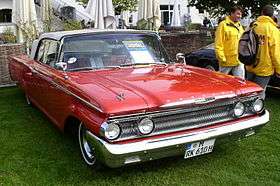 | |
| Overview | |
| Model years | 1959–1960 |
| Body and chassis | |
| Body style | 4-door sedan 4-door hardtop 2-door hardtop 2-door convertible |
| Related | Mercury Park Lane Mercury Montclair Mercury Colony Park Mercury Commuter Mercury Voyager |
| Powertrain | |
| Engine | 312 cu in (5.1 L) Ford Y-block V8 383 cu in (6.3 L) MEL V8 430 cu in (7.0 L) MEL V8 |
| Transmission | 3-speed manual 3-speed Merc-O-Matic automatic |
| Dimensions | |
| Wheelbase | 126.0 in (3,200 mm) |
| Length | 1959: 217.8 in (5,532 mm) 1960: 219.2 in (5,568 mm) |
.jpg)
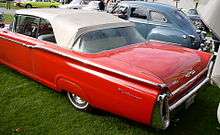
With the discontinuation of the low-price Medalist after the 1956 model year and a trend towards fuel economy, the 1959 Monterey returned to the 312, with 210 hp (160 kW).[19]
1961–1964
.jpg)
| Fifth generation | |
|---|---|
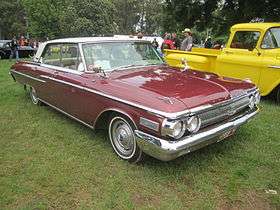 | |
| Overview | |
| Model years | 1961–1964 |
| Body and chassis | |
| Body style | 4-door sedan 4-door hardtop 2-door hardtop 2-door convertible 4-door station wagon |
| Related | Mercury Meteor Mercury Colony Park Mercury Commuter Ford Galaxie Ford Country Squire |
| Powertrain | |
| Engine | 223 cu in (3.7 L) Mileage Maker I6 292 cu in (4.8 L) Ford Y-block V8 352 cu in (5.8 L) FE V8 390 cu in (6.4 L) FE V8 406 cu in (6.7 L) FE V8 |
| Transmission | 3-speed manual 4-speed manual 3-speed Merc-O-Matic automatic[20] |
| Dimensions | |
| Wheelbase | 120.0 in (3,050 mm) |
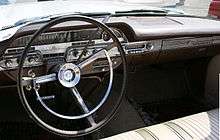
Mercury's full-size offerings were completely revamped for 1961. Bodies, interiors, and chassis were basically the same as the big Ford's, although trim was different in order to distinguish the marques. The Montclair and Park Lane were discontinued and the Meteor was added at the bottom of the range, making Monterey once again the top of Mercury's lineup. The 292 cu in (4.8 L) Ford Y-block was standard, with 352 cu in (5.8 L) and 390 cu in (6.4 L) versions of the FE V8 available.[21]
The Meteor nameplate was moved to a new intermediate line for 1962, so the Monterey 6 with a 135 hp (101 kW) 223 cu in (3.7 L) Mileage Maker straight-six was added to fill the gap, but only for this year.[21]
1963 brought the return of the "Breezeway" window, a powered reverse slanted rear window that was borrowed from Ford's station wagons, and was first used on the Mercury Turnpike Cruiser and the 1958–60 Lincoln Continental. It also brought a 406 cu in (6.7 L) FE engine. The six-cylinder, and 292 and 352 V8s were dropped and the 390 V8 became the standard engine with 250 horsepower and two-barrel carburetor with a 300-horsepower four-barrel version optional. At mid-year, the fastback Marauder was introduced.[1] Mid-1963 saw the introduction of the "Marauder," basically the 1963 1/2 Ford Sports Hardtop "fastback" roofline adapted to the Mercury body. A performance "S-55" package included a big-block 300-bhp 390 V8 and a sporty interior that was similar to the Ford Galaxie 500/XL.
Monterey became the entry-level full-size Mercury again for 1964, with the return of the Montclair and Park Lane. Grilles and taillights were restyled and toned down a bit, making this model especially attractive, a big car but not bulky-looking. The 406 was replaced by the 427 cu in (7.0 L) version, producing 410 hp (310 kW) standard with an option for 425 hp (317 kW).[1] The Marauder fastback hardtop continued to be offered in all three Mercury series.
 1961 Mercury Monterey Sedan
1961 Mercury Monterey Sedan 1962 Mercury Monterey convertible
1962 Mercury Monterey convertible 1962 Mercury Monterey convertible rear
1962 Mercury Monterey convertible rear 1963 Monterey
1963 Monterey Rear "Breezeway" window
Rear "Breezeway" window
1965–1968
| Sixth generation | |
|---|---|
.jpg) 1967 Mercury Monterey convertible | |
| Overview | |
| Model years | 1965–1968 |
| Body and chassis | |
| Body style | 4-door sedan 4-door hardtop 2-door hardtop 2-door convertible |
| Related | Mercury Park Lane Mercury Montclair Mercury Colony Park Mercury Commuter Ford Galaxie Ford LTD Ford Country Squire |
| Powertrain | |
| Engine | 390 cu in (6.4 L) FE V8 410 cu in (6.7 L) FE V8 427 cu in (7.0 L) FE V8 428 cu in (7.0 L) FE V8 |
| Transmission | 3-speed manual 4-speed manual 3-speed Merc-O-Matic automatic 3-speed C6 automatic |
| Dimensions | |
| Wheelbase | 123.0 in (3,120 mm) |
.jpg)
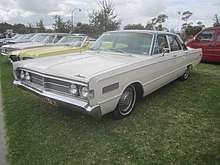
The full-size Mercurys were redesigned for 1965 with a new torque-box frame and a more slab-sided look, reflecting the popularity of the Continental. The Breezeway window was now only available on pillared sedans, with all two door hardtops being fastbacks.
The Mercury-exclusive 410 cu in (6.7 L) and the 428 cu in (7.0 L) FE engines were added for 1966. 1967 brought a refresh, and the vertical Breezeway roofline disappeared although they could still be had with a drop-down rear window. The 410 was dropped for 1968.[1]
1969–1974
| Seventh generation | |
|---|---|
.jpg) 1972 Mercury Monterey | |
| Overview | |
| Model years | 1969–1974 |
| Body and chassis | |
| Body style | 4-door sedan 4-door hardtop 2-door hardtop 2-door convertible 4-door station wagon |
| Related | Mercury Marquis Mercury Colony Park Ford LTD Ford Galaxie Ford Country Squire |
| Powertrain | |
| Engine | 390 cu in (6.4 L) FE V8 400 cu in (6.6 L) Cleveland V8 429 cu in (7.0 L) 385-series V8 460 cu in (7.5 L) 385-series V8 |
| Transmission | 3-speed manual 4-speed manual 3-speed C6 automatic |
| Dimensions | |
| Wheelbase | 124.0 in (3,150 mm) |
For 1969, the Mercury model line underwent a significant revision, with the Montclair repackaged as the Monterey Custom trim level. An all-new chassis made its debut; sedans were based on a 124-inch wheelbase, Monterey station wagons used a 121-inch wheelbase (alongside Ford station wagons and sedans).[22][23] Following the expansion of the Marquis to a full model range, the Monterey was the base-trim model range, offered as a two-door hardtop, two-door convertible, four-door sedan, four-door hardtop.[24] In another revision, Mercury station wagons were no longer a separate model range, with the Mercury Commuter renamed the Monterey station wagon.
More rounded in styling than the previous generation, the Monterey and Monterey Custom were distinguished from the Marquis by their lack of hidden headlights, differing from Fords in grille and taillamp styling. For 1970, the grille underwent a further revision and wider taillamps were introduced to better differentiate the Monterey from its Ford counterparts.
In 1971, the Mercury full-size model range underwent a exterior restyling. While retaining the roofline shared with Ford, the Monterey adopted design elements similar to the larger Lincoln Continental, included its wide-pointing grille and taillamps. In a major change, Ford and Mercury introduced "pillarless hardtops", using frameless door glass on both hardtops and four-door sedans; vent windows were discontinued. Redesigned door handles no longer protruded from the exterior; rear fender skirts were standardized on all full-size Mercury sedans except the base-trim Monterey. The Monterey and Marquis convertibles were discontinued for 1971, leaving the Cougar as the sole Mercury convertible.
For 1972, the Monterey underwent minor exterior revisions, replacing the full-width horizontal grille for an egg-crate style design. In line with federal regulations, front seatbelt warning buzzers were introduced. For the first time, an automatic transmission was standard, along with power steering and power brakes.[23]
For 1973, the full-size Mercury line underwent an exterior redesign, adapting to the introduction of federally mandated 5 mph bumpers.[23] Along with slightly more angular styling, the Monterey adapted much of the front fascia of the Ford Galaxie, distinguished largely by a centered eggcrate grille, with fender skirts becoming an option.[25] For 1974, the Monterey saw a revision to its grille and headlight trim.
For 1975, Mercury discontinued the Monterey, consolidating its full-size range down to the Marquis.[23] The same year, the Grand Marquis was introduced as a sub-model, becoming a distinct model range in 1983.
Approximately 7,850,000 full-size Fords and Mercurys were sold over 1969–78; this makes it the second best selling Ford automobile platform after the Ford Model T.[23][26][27]
.jpg) 1969 Mercury Monterey convertible
1969 Mercury Monterey convertible.jpg) 1969 Mercury Monterey convertible, rear
1969 Mercury Monterey convertible, rear- 1971 Mercury Monterey four-door hardtop
- 1971 Mercury Monterey four-door hardtop, rear
.jpg) 1972 Mercury Monterey Custom 4-door hardtop
1972 Mercury Monterey Custom 4-door hardtop.jpg) 1972 Mercury Monterey Custom, rear
1972 Mercury Monterey Custom, rear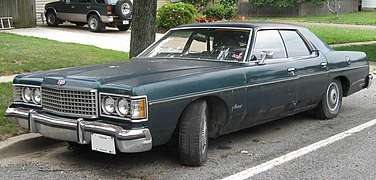 1973 Mercury Monterey
1973 Mercury Monterey.jpg) 1974 Mercury Monterey
1974 Mercury Monterey.jpg) 1974 Mercury Monterey, rear
1974 Mercury Monterey, rear.jpg) 1974 Mercury Monterey interior (front seat)
1974 Mercury Monterey interior (front seat).jpg) 1974 Mercury Monterey interior (rear seat)
1974 Mercury Monterey interior (rear seat)
Powertrain
The 351 Windsor and 400 cu in (6.6 L) Cleveland V8s were added for 1971, the final year for the 390. The 429 V8, which was standard on the Marquis beginning in 1969, was available as an extra cost option on all Monterey models each year including a two-barrel 320-horsepower version and a four-barrel 360-horsepower option from 1969 to 1971. Both of those 429s were replaced by single 209 net horsepower 429 four-barrel for 1972, which was designed to run on regular, low lead or unleaded gasoline as was the case with all Ford Motor Company engines starting with the 1972 model year.[23] Engine offerings for 1973–74 included the 351 Windsor two-barrel standard on base Montereys and the 400 Cleveland two-barrel standard on Monterey Custom and optional on base models. The 429 V8 was discontinued after 1973 and Lincoln's 460 V8 became the top option on all models for 1974.
The Monterey in Canada
After 1963, the Monterey was not sold in Canada, but was supplanted by the resurrected Meteor. Meteor competed in the low-priced field, but its upper trim series (Montcalm and LeMoyne) were typically very similar to the U.S. Monterey both in styling and appointments. Meteor continued as a separate marque through 1976 (1975–76 models continued the 1974 Monterey's front end styling[23]) after which the name was applied to a base trim version of the Marquis, as the "Mercury Marquis Meteor" through 1981.
References
- "Full-Size Mercury Cars of the 1960s". How Mercury Cars Work. HowStuffWorks.com. Retrieved 2008-12-03.
- Flory, Jr., J. "Kelly" (2008). American Cars, 1946–1959 Every Model Every Year. McFarland & Company, Inc., Publishers. ISBN 978-0-7864-3229-5.
- "Directory Index: Mercury/1952 Mercury/1952 Mercury Prestige Brochure". Oldcarbrochures.com. Retrieved 2011-11-20.
- http://oldcarbrochures.org/index.php/New-Brochures---January/1953-Mercury-Foldout/1953-Mercury-Foldout-02
- "Directory Index: Mercury/1952 Mercury/1952 Mercury Prestige Brochure". Oldcarbrochures.com. Retrieved 2013-03-01.
- "Directory Index: Mercury/1952 Mercury/1952 Mercury Prestige Brochure". Oldcarbrochures.com. Retrieved 2011-11-20.
- Flory, J. "Kelly", Jr. American Cars 1946–1959 (Jefferson, NC: McFarland & Coy, 2008), p.515.
- “Mercury’s New Monterey.” Chicago Tribune, 21 February 1954.
- “Mercury Sends Experimental MX-800 to Show.” Chicago Tribune, 14 March 1954.
- “1st Showing in Chicago…The New Mercury Monterey XM-800.” (Chicago Auto Show Display Ad) Chicago Tribune, 14 March 1954.
- "Directory Index: Mercury/1955 Mercury/album". Oldcarbrochures.com. Retrieved 2011-11-20.
- Consumer Guide. "1955, 1956, 1957 Mercury Cars". How Mercury Cars Work. HowStuffWorks.com. Retrieved 2008-12-09.
- "Directory Index: Mercury/1955 Mercury/album". Oldcarbrochures.com. Retrieved 2012-08-17.
- "Directory Index: Mercury/1955 Mercury/album". Oldcarbrochures.com. Retrieved 2012-08-17.
- "Directory Index: Mercury/1956 Mercury/album 002". Oldcarbrochures.com. Retrieved 2012-08-17.
- http://oldcarbrochures.org/index.php/New-Brochures---February/1957-Mercury-Quick-Facts-Booklet/1957-Mercury-Quick-Facts-13
- http://oldcarbrochures.org/index.php/New-Brochures---February/1957-Mercury-Quick-Facts-Booklet/1957-Mercury-Quick-Facts-14
- John Gunnell, Standard Catalog of American Cars 1946–1975, Revised 4th Edition, page 516
- Consumer Guide. "1958, 1959 Mercurys". How Mercury Cars Work. HowStuffWorks.com. Retrieved 2008-12-09.
- "Directory Index: Mercury/1964 Mercury/1964 Mercury Full Size Brochure". Oldcarbrochures.com. Retrieved 2011-11-20.
- Consumer Guide. "The 1960s: More Mercury Models, Fewer Buyers". How Mercury Cars Work. HowStuffWorks.com. Retrieved 2008-12-09.
- "Directory Index: Mercury/1969 Mercury/1969_Mercury_Full_Line_Brochure". www.oldcarbrochures.com. Retrieved 2019-04-29.
- Odin, L.C. A concise guide to the Ford and Mercury full-size automobile production 1969-1978. Belvedere Publishing, 2016. ASIN: B01HE91Y4K.
- "Directory Index: Mercury/1969 Mercury/1969_Mercury_Full_Size_Brochure". www.oldcarbrochures.com. Retrieved 2019-04-29.
- "Directory Index: Mercury/1973 Mercury/1973 Mercury Full Line Brochure". www.oldcarbrochures.com. Retrieved 2019-04-29.
- Kowalke, Ron (1997). Standard Catalog of American Cars 1946–1975. Krause publications. ISBN 0-87341-521-3.
- Flammang, James Standard Catalog of American Cars 1976–1999 3rd Edition (Iola, WI: Krause Publications, Inc 1999)